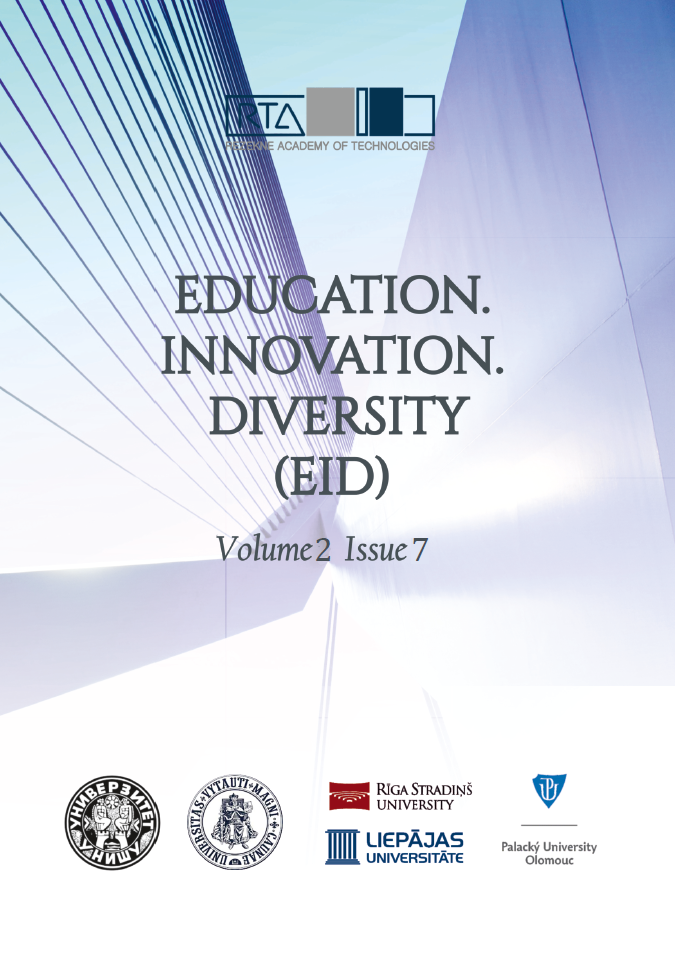EVALUATION OF HEALTHY LIFESTYLE HABITS AND WELLNESS OF UNIVERSITY STUDENTS IN A CROSS-SECTION OF FOUR ACADEMIC YEARS
DOI:
https://doi.org/10.17770/eid2023.2.7344Keywords:
healthy lifestyle, physical activity, university students, wellnessAbstract
Statistics on healthy lifestyle habits of Latvian population indicate that the number of adults who engage in sufficient physical activity is decreasing, and also for university students the succession of minimum physical activity is not fully ensured. Latvian National Development and Sports Policy Guidelines (Latvijas Vēstnesis, 2022), as well as other binding health policy documents contain references towards the need to support the healthy lifestyle and wellness of university students, especially highlighting the insufficient level of physical activity and emotional wellness among Latvian population, including students. The problem issue exists in the long-term spectrum, and for various reasons it is only partially possible to implement in universities the measures stated in policy documents. The aim of the study: to analyse students' healthy lifestyle habits and wellness dynamics over four years of studies, assessing the dynamics of healthy lifestyle habits and wellness level depending on the year of study, students' age and the study programme. In each academic year, the first- and second-year students were involved in the survey, a total of N=455 respondents. Research methodology: a tailored survey (Robbins, et.al., 2011), students' self-assessment of healthy lifestyle habits and levels of physical, emotional, mental, intellectual and job wellness, 86 questions in total. The results of the study indicate a decreasing tendency for the indicators of physical activity and emotional wellness, and statistically significant differences in the indicators of mental and emotional wellness can be observed depending on the age of students. No statistically significant differences were found depending on the study programme.
References
Abrantes, L.C.S., de Souza de Morais, N., Gonçalves, V.S.S. et al. (2022). Physical activity and quality of life among college students without comorbidities for cardiometabolic diseases: systematic review and meta-analysis. Qual Life Res 31, 1933–1962 (2022). DOI: https://doi.org/10.1007/s11136-021-03035-5
Augstākās izglītības reforma (n.d.). Retrieved from https://www.izm.gov.lv/lv/augstakas-izglitibas-reforma
Assaf, I., Brieteh, F., Tfaily, M., El-Baida, M., Kadry, S., & Balusamy, B. (2019). Students university healthy lifestyle practice: quantitative analysis. Health information science and systems, 7, 1-12. DOI: https://doi.org/10.1007%2Fs13755-019-0068-2
Elmagd, M.A., Mossa, A. H., Sami, M.M., El-Marsafawy, Jadaan, O.Al., Mudawi, M.S. E. (2015). The Impact of Physical Activity on the Academic Performance among Medical and Health Sciences Students: A Cross Sectional Study from RAKMHSU - Ras Alkhaimah-UAE. International Journal of Physical Education, Sports and Health 2015; 2(1), 92-95.
Gardner, B., & Lally, P. (2018). Modelling habit formation and its determinants. The psychology of habit: Theory, mechanisms, change, and contexts, 207-229. DOI: https://doi.org/10.1007/978-3-319-97529-0_12
Gejalakshmi, M., Swaminathan, S. (2022). Academic Performance in relation to Physical Activity among University Students during COVID 19 Pandemic Measures. J Res Med Dent Sci, 2022, 10(11), 159-165. Retrieved from: https://www.jrmds.in/articles/academic-performance-in-relation-to-physical-activity-among-university-students-during-covid-19-pandemic-measures.pdf
Hammoudi, Halat, D., Hallit, S., Younes, S. et al. (2023). Exploring the effects of health behaviors and mental health on students’ academic achievement: a cross-sectional study on lebanese university students. BMC Public Health, 23, 1228(2023). DOI: https://doi.org/10.1186/s12889-023-16184-8
Henshaw, B. & Archibald, J. G. (2013). The Benefits and Barriers of Physical Activity among College Students. Georgia Journal of College Student Affairs, 29(1). DOI: https://doi.org/10.20429/gcpa.2013.290102
IZM (2022). Konceptuālais ziņojums “Par turpmāko augstākās Izglītības finansēšanu”. Izglītības un zinātnes ministrija Augstākās izglītības, zinātnes un inovāciju departaments. Retrieved from: https://www.izm.gov.lv/lv/media/17243/download
IZM (2021). Pārskats par Latvijas augstāko izglītību 2020. gadā. Galvenie statistikas dati. Retrieved from: https://www.viis.gov.lv/sites/default/files/2021-12/parskats_par_latvijas_augstako_izglitibu_2020.pdf
Kljajević, V., Stanković, M., Đorđević, D., Trkulja-Petković. D., Jovanović, R., Plazibat, K., Oršolić, M., Čurić, M., & Sporiš, G. (2021). Physical Activity and Physical Fitness among University Students. A Systematic Review. Int J Environ Res Public Health, 19(1), 158. DOI: https://doi.org/10.3390/ijerph19010158
Latvijas Vēstnesis (2004). Par Sporta politikas pamatnostādnēm 2004.–2009.gadam. Ministru kabineta rīkojums Nr.632. Rīgā 2004.gada 15.septembrī (prot. Nr.53 37.§). Retrieved from: https://www.vestnesis.lv/ta/id/93733-par-sporta-politikas-pamatnostadnem-2004-2012-gadam
Latvijas Vēstnesis (2022). Par Sporta politikas pamatnostādnēm 2022.–2027. gadam. Ministru kabineta rīkojums Nr. 397, Rīgā 2022. gada 31. maijā (prot. Nr. 29 46. §). Retrieved from: https://www.vestnesis.lv/op/2022/107.7
Lawrence, E., Mollborn, S., Joshua Goode, J., & Pampel, F. (2020). Health Lifestyles and the Transition to Adulthood. Socius, 6. DOI: https://doi.org/10.1177/2378023120942070
Müller, C., El-Ansari, K., & El Ansari, W. (2022). Health-Promoting Behavior and Lifestyle Characteristics of Students as a Function of Sex and Academic Level. Int J Environ Res Public Health, 19(12). DOI: https://doi.org/10.3390/ijerph19127539
Redondo-Flórez, L., Ramos-Campo, D.J., & Clemente-Suárez, V.J. (2022). Relationship between Physical Fitness and Academic Performance in University Students. Int J Environ Res Public Health, 19(22). DOI: https://doi.org/10.3390/ijerph192214750
Robbins, G., Powers, D., & Burgess, S. A. (2011). Wellness Way of Life. 9/e.5. McGraw Hill.
Rubana, I. M. (1998). Tava veselība. 1.daļa Veselīgs dzīvesveids. Rīga: RaKa.
Saeima (2020). Latvijas nacionālais attīstības plāns 2021.–2027. gadam. Retrieved from: https://www.pkc.gov.lv/sites/default/files/inline-files/NAP2027_apstiprin%C4%81ts%20Saeim%C4%81_1.pdf
Silva, R. M.F., Mendonc¸ C.R., Azevedo, V. D., Memon, A. R., Noll, S., & Noll, M. (2022). Barriers to high school and university students’ physical activity: A systematic review. PLoS One. 2022; 17(4), e0265913. DOI: https://doi.org/10.1371/journal.pone.0265913
Špona, A. (2006). Audzināšanas process teorijā un praksē. Rīga: RaKa
Tafireyi, C.G.S. & Grace, J.M. (2022). The physical activity and health promotion activities of global university students: a review of reviews. Global Health Promotion, 29(4), 63-73. DOI: https://doi.org/10.1177/17579759221099308
Valsts izglītības satura centrs. (2020). Skolotāju profesijas standarts. Retrieved from: https://registri.visc.gov.lv/profizglitiba/nks_stand_saraksts_mk_not_626.shtml
Veselības veicināšanas un slimību profilakses plāns. (2022). Rīga. Retrieved from: https://www.esparveselibu.lv/sites/default/files/2022-11/Vesel%C4%ABbas_veicin%C4%81%C5%A1anas_pl%C4%81ns.pdf
Veselības veicināšanas un slimību profilakses plāns (2022). Rīga. Retrieved from: https://esparveselibu.lv/sites/default/files/2022-11/Vesel%C4%ABbas_veicin%C4%81%C5%A1anas_pl%C4%81ns.pdf
VM (2019). Rekomendācijas fizisko aktivitāšu veicināšanai Latvijas iedzīvotājiem (politikas veidotājiem un īstenotājiem). Retrieved from: https://www.vm.gov.lv/lv/media/6408/download
Tafireyi, C.G.S. & Grace, J.M. (2022). The physical activity and health promotion activities of global university students: a review of reviews. Global Health Promotion, 29(4), 63-73. DOI: https://doi.org/10.1177/17579759221099308
Zhang, Y. & Zhang, C. (2022). The influence of social support on the physical exercise behavior of college students: The mediating role of self-efficacy. Front. Psychol, 13, 1037518. DOI: https://doi.org/10.3389/fpsyg.2022.1037518
Wood, W., Neal, D. T. (2016). Healthy through habit: Interventions for initiating & maintaining health behavior change. Behavioral Science & Policy, 2(1), 71–83. DOI: https://doi.org/10.1177/237946151600200109
Downloads
Published
Issue
Section
License
Copyright (c) 2023 Education. Innovation. Diversity.

This work is licensed under a Creative Commons Attribution 4.0 International License.






